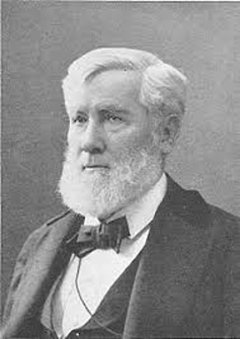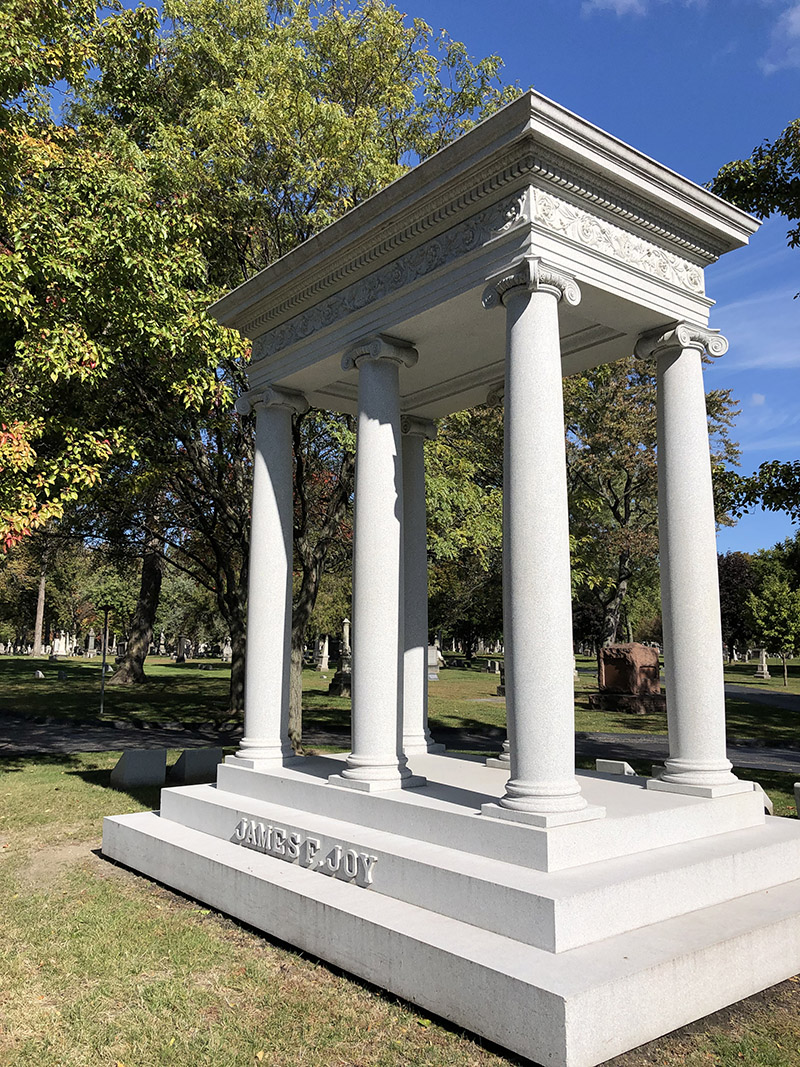 Click here to view or download a PDF.
Click here to view or download a PDF.
James Joy was born in Durham, New Hampshire on December 2, 1810 and attended Dartmouth College and Harvard Law School. After graduating in 1836, Joy moved to Detroit and formed the law firm of Joy & Porter with George F. Porter. He rose to prominence as a lawyer and later as a railroad entrepreneur. The firm was chosen as legal counsel for the Bank of Michigan in 1838. That same year, Joy was selected to be school inspector for the City of Detroit.
Joy’s entry into the railroad business came after the State of Michigan, which had purchased the Detroit & St. Joseph Railroad in 1837, went bankrupt in 1846 and was forced to sell off public works to meet its debt. Joy and investor John M. Forbes brokered the purchase of the Detroit & St. Joseph Railroad, also called Central Railroad, and officially renamed it the Michigan Central Railroad (MCRR). The plan was to construct a line to Chicago.
Acting as legal counsel for the new railroad, Joy bought out numerous railroads crossing Indiana, but Illinois laws blocked him there. Joy was able to break the stalemate with the aid of a bright young lawyer, Abraham Lincoln. Working together on the case sparked a friendship between the two that continued for life.
In 1847, Joy participated in a nationally significant trial, Francis Giltner v. Charles T. Gorham et al, concerning the attempted abduction of the Crosswhite family in Marshall, Michigan. In the early hours before dawn on the morning of January 26, 1847, Francis Troutman broke down the Crosswhite’s door to forcibly take the family into slavery. Crosswhite fired a shot to alert his neighbors. The neighbors, a mix of black and white people, surrounded the Crosswhite family and prevented Troutman, along with four Kentuckians and a deputy sheriff, from taking the family. Troutman returned to Michigan in the summer of 1847 and sued the citizens of Marshall, Michigan for helping the Crosswhite family escape. Joy was part of a team of attorneys who defended the citizens of Marshall.
Joy also made a name for himself defending Giles Rose in October 1850. Joy was unsuccessful representing Rose as a fugitive from bondage in U. S. District Court. Detroiters, however, raised money to purchase Rose’s freedom.
Joy served as legal counsel for the American locks project at Sault Sainte Marie, completed in 1855. Because of his growing influence throughout the state, and despite his initial objections, he was elected as the Detroit representative to the Michigan legislature in 1861. The same year, he won an important land dispute case in Chicago for the Michigan Central, gaining him national recognition as a top railroad litigator. In 1867 he was elected president of the MCRR, a position he held for ten years.
Responsible for over 1,600 miles of track in Michigan alone, Joy oversaw the expansion of railways through various states and Canada, even overseeing the construction of the first railway bridge over the Missouri River. His dominance of the railroad industry in the region earned him enemies, however, and in 1877 a contingent led by William H. Vanderbilt attempted a takeover of the MCRR and Joy left the presidency.
He later became president of the Detroit Post & Tribune, a president and director of the Wabash, St. Louis & Pacific Railroad, and formed the Detroit Union Depot Company to manage its local assets. Joy remained an important influence in the Detroit business community.
James Joy died on September 24, 1896 and is buried in Cypress Mound at Elmwood. His monument his pictured below.
Joy is listed in Elmwood’s Underground Railroad Network to Freedom Self-Guided Tour Map.


This material is based upon work assisted by a grant from the Association for the Study of African American Life and History (ASALH), funded by the Department of the Interior, National Park Service. Any opinions, findings, and conclusions or recommendations expressed in the material are those of the author(s) and do not necessarily reflect the views of ASALH or the Department of the Interior. Elmwood Cemetery’s Network to Freedom Application was completed by Carol Mull and Gabrielle Lucci. This biography was completed based upon the Application and records available through Elmwood Cemetery, Detroit Historical Society, Burton Historical Library, Military Records of the United States, Michigan Historical Center, and various information sources.
